Abstract
- Infectious disease public health exposure may be associated with flush-related aerosols;
- New appropriate and effective methodology should be established to evaluate flush-related aerosol generation;
- A new experimental apparatus was tested;
- The results confirmed that toilet flushing did increase airborne particle concentrations in the bathroom air.

Introduction
- Aerosolized pathogenic microorganisms can be responsible for human respiratory infections.
- Gastroenteritis and norovirus remain the most common aerosolized microorganisms in toilets (Nazaroff, 2011).
- Different methods of research were implemented (Johnson & Lynch, 2008; Johnson et al., 2013).
- Earlier technical challenges justify the need to develop approaches and methods for measuring flush-related bioaerosol generation.

Purpose
The purpose was to develop and test an apparatus and method for measuring aerosol generation related to toilet flushing.
Rationale:
- Questionable validity of earlier findings;
- Bioaerosol transmission leading to disease outbreaks (Johnson et al., 2013);
- The need to reduce the scope of infectious diseases;
- The need to develop new guidelines for preventing airborne infectious diseases.

Literature Review: Aerosol Generation
- Aerosol generation and release have long been a matter of public health concerns (Sanchez-Monedero, Stentiford & Urpilainen, 2005).
- Any public toilet increases the risks of airborne infections.
- The direction of bioaerosolization depends on the physical principles of speed and transport.
- The current methods fail to control the dynamics of virus-laden bioaerosols (Morawska, 2005).
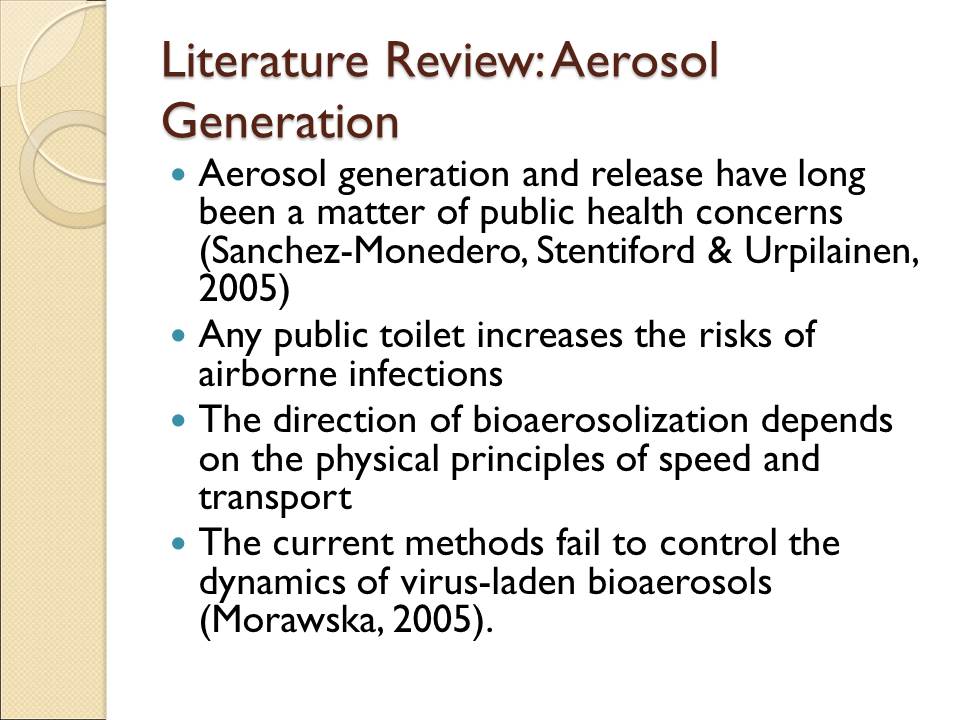
Literature Review: Why Important
- The problem of bioaerosol generation is quite serious.
- Sewage-related bioaerosols can be potentially responsible for SARS.
- Toilet flushing generates major and minor droplets carrying a variety of microorganisms (Johnson et al., 2013).
- Bioaerosolization of toilet flushing cannot be confirmed without effective analytical methods.
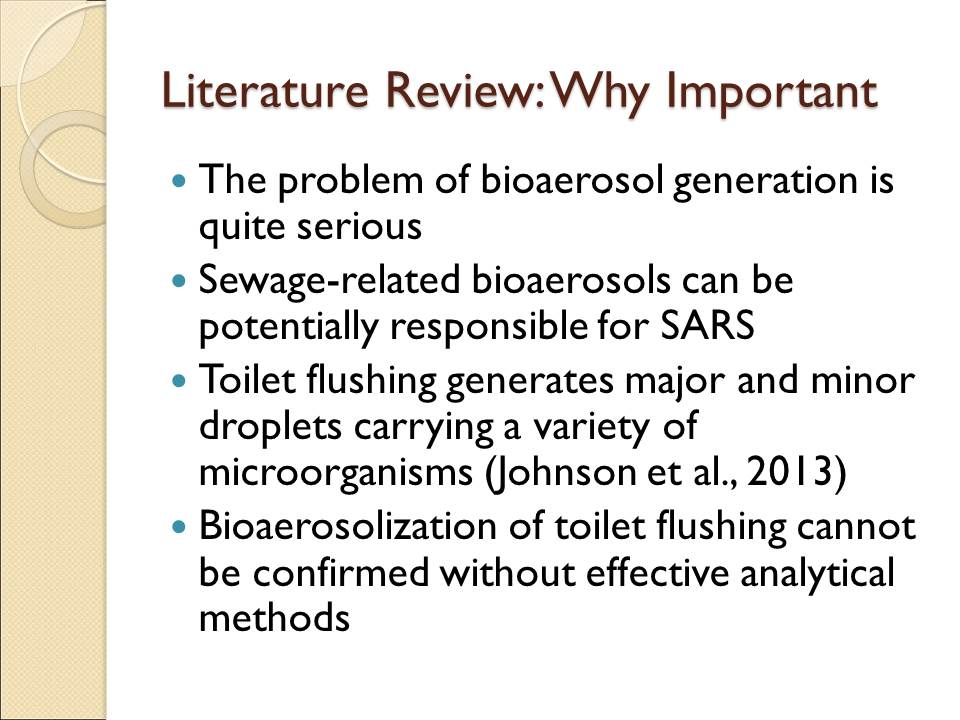
Literature Review: Sources of Aerosolized Microorganisms in Toilets
- Toilet flushing is a source and driver of aerosolized microorganisms (Leed, 2011).
- Contact transmission is a result of contamination with flush droplets (Johnson et al., 2012).
- Toilet flushing is a source of E. coli (Gerba et al., 1975), as well as gastroenteritis, Clostridium difficile, and S. Epidermidis (Best et al., 2012; Johnson et al., 2012; Nazaroff, 2011).
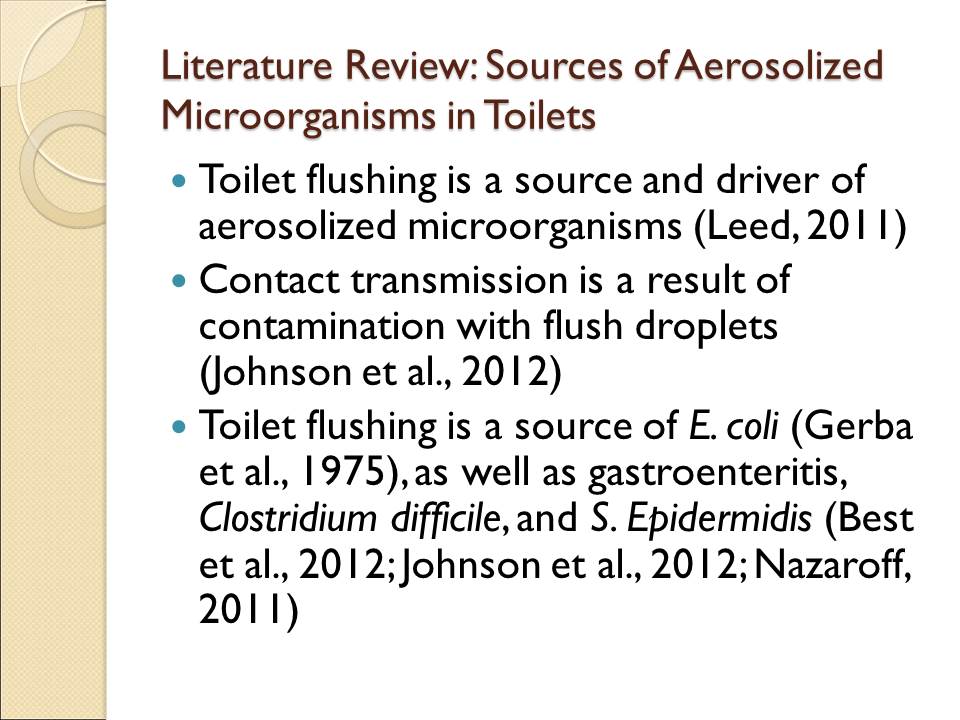
Toilet Flushes and Aerosol Generation: Review of Methods
Wallis et al. (1985)
- The researchers detected human enteric viruses from aerosols by using filterite filters and glycine buffer;
- Even with the air flowing at 100 liters per minute, no virus passed the filter.
Johnson and Lynch (2008)
- The researchers tested an analytical method for counting particles;
- The method proved to be effective enough to measure the number of surrogate bioaerosol particles.

Methods and Materials: Variables
- Purpose: To develop and test an apparatus and method for measuring aerosol generation associated with toilet flushing.
- Independent variable: toilet flush.
- Dependent variable: particles concentration.

Instrumentation
- Clear cylindrical 4-feet tall, 18-inches high wide plastic chamber.
- HEPA filtration system.
- Holmes ®True | HEPA Allergen Remover.
- Model 3321 Aerodynamic Particle Sizer® Spectrometer.
- Renegair® pump.

Setting
The experiment was conducted in two half and one full residential standard bathrooms.
Both bathrooms were equipped with 1.6 GPF (6.0 LPF) toilets.

Procedure
Divided into two stages;
- The first was used to confirm that toilet flushing leads to aerosol generation;
- The second was used to test the efficacy of the proposed method for measuring bioaerosolization in toilets.
- Basic Lysol cleaner was used to reduce background particles.
- The chamber was 4 feet tall and 18 inches wide;
- HEPA air intake filters were on all sides;
- The HEPA exhaust/vacuum filter was located on the top of the chamber;
- The sampling port was connected to the APS monitor with the help of a tube (1 inch in diameter, 40 inches long).
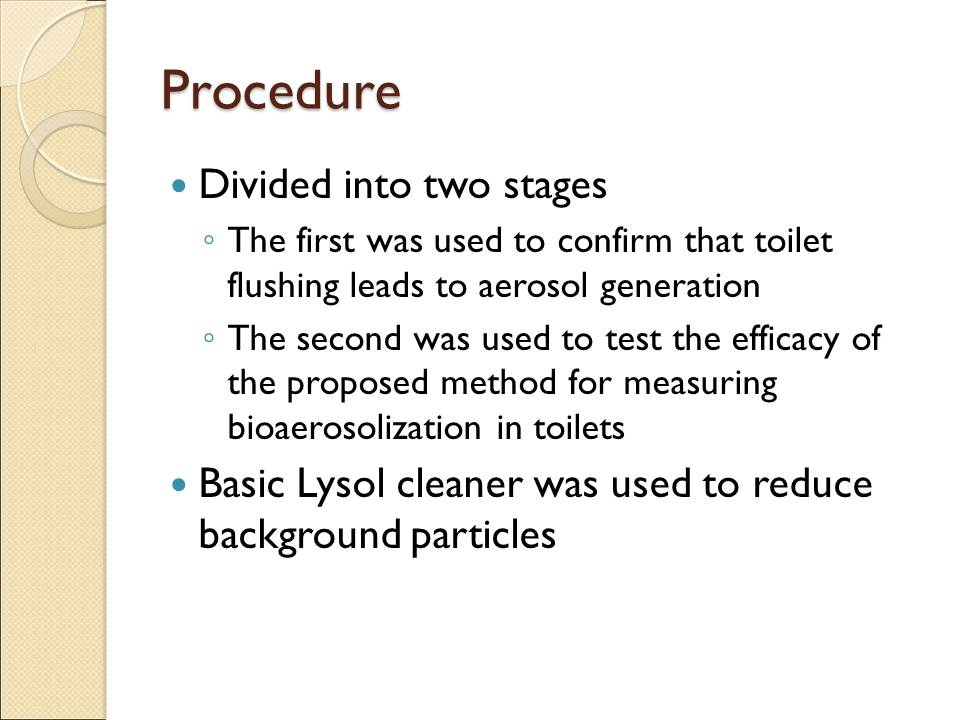

Experiment
- Bathrooms were sealed with duck tapes;
- Holmes® Allergen Remover was switched to run 30 minutes before toilet flushing;
- Three toilet flushes were initiated with a one-minute interval;
- TSI Aerodynamic Particle Sizer 3321 was used to measure aerosol generation after each flush.

Experiment: Graphics


Procedure, Sample, and Toilet Seeding
- The Regenerative Pump was used to filter the air out of the chamber;
- Medium duty white caulk gum was used as a gasket between the toilet bowl rim and the chamber;
- Samples were collected every minute, during 1 hour (60 minutes);
- Toilet seeding was used to imitate human excretion.

Clear Cylindrical Air-Tight Chamber

Data Analysis
- Statistical analyses;
- Basic Excel and STATA;
- Two sample t-tests, unequal variances, and mean differences between total counts;
- Individual particle sizes.

Results
Experiment 1, Toilet 1
- Flushing generates aerosols;
- 133.4 particles/cm3, SD 72.2 with flushing against 42.9 particles/cm3, SD 7.8 without flushing.
Experiment 2, Toilet 1
- seeded with 0.05 µm polystyrene beads;
- flushing leads to an increase in particle counts;
- 177.9 particles/cm3, SD 162.3 with flushing against 50.1 particles/cm3, SD 14.9 without flushing.
Experiment 3, Toilet 1
- Results are similar to Experiment 1 without seeding;
- Individual particle counts are lower than in Experiment 1;
- Patterns of changes are similar to Experiment 1.
Experiment 4, Toilet 2
- Different bathroom;
- No seeding;
- Flushing generated aerosols;
- 107.6 particles/cm3 with flushing against 30.1 particles/cm3 without it.


Discussion
- The results confirm those of Johnson et al. (2013);
- It is the first study to use a TSI Aerodynamic Particle Sizer for changes in particle counts;
- All four experiments confirm that toilet flushing leads to an increase in particle counts;
- Changes in particle counts are related to their size.

Limitations and Recommendations
Limitations
- The experiments were conducted in household toilets;
- The air pumped in and out of the chamber could contribute to changes in aerosolized particle counts;
- Polystyrene beads were used to imitate seeding.
Recommendations
- Future studies are needed to understand the relationship between particle counts and size.
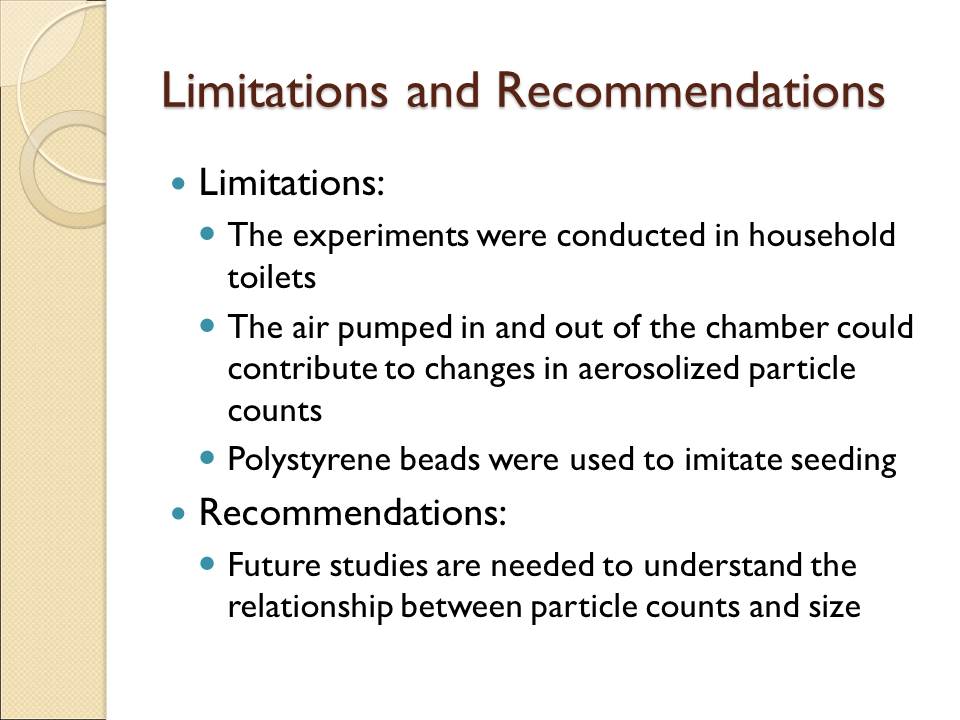
References
Best, E.L., Sandoe, J.A.T. & Wilcox, M.H. (2012). Potential for aerosolization of Clostridium difficile after flushing toilets: The role of toilet lids in reducing environmental contamination risks. Journal of Hospital Infection, 80(1), 1-5.
Gerba, C.P., Wallis, C. & Melnick, J.L. (1975). Microbiological hazards of household toilets: Droplet production and the fate of residual organisms. Applied Microbiology, 30(2), 229-237.
Johnson, D.L. & Lynch, R.A. (2008). An efficient analytical method for particle counting in evaluating airborne infectious isolation containment using fluorescent microspheres. Journal of Occupational and Environmental Hygiene, 5(4), 271-277.
Johnson, D.L., Mead, K.R., Lynch, R.A. & Hirst, D.V. (2013). Lifting the lid on toilet plume aerosol: A literature review with suggestions for future research. American Journal of Infection Control, 41(3), 254-258.
Johnson, D., Lynch, R., Marshall, C., Mead, K. & Hirst, D. (2013). Aerosol generation by modern flush toilets. Aerosol Science and Technology, 47(9), 1047-1057.
Leed, S.W. (2011). Solving indoor airborne disease transmission problems. Engineered Systems, 56-61. Web.
Morawska, L. Droplet fate in indoor environments, or can we prevent the spread of infection?, in Yang,X., Zhao, B.,& Zhao, R. (Eds.) Proceedings of Indoor Air 2005 : the 10th International Conference on Indoor Air Quality and Climate, Springer, Beijing, China, pp. 9-23.
Nazaroff, W.W. (2011). Norovirus, gastroenteritis, and indoor environmental quality. Indoor Air, 21(5), 353-356.
Sanchez-Monedero, M.A., Stentiford, E.I. & Urpilainen, S.T. (2005). Bioaerosol generation at large-scale green waste composting plants. Journal of Air & Waste Management, 55(5), 612-618.
Wallis, C., Melnick, J.L., Rao, V.C. & Sox, T.E. (1985). Method for detecting viruses in aerosols. Applied and Environmental Microbiology, 50(5), 1181-1186.